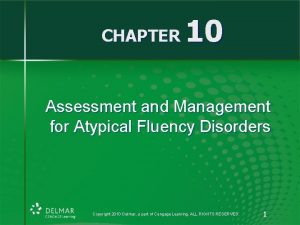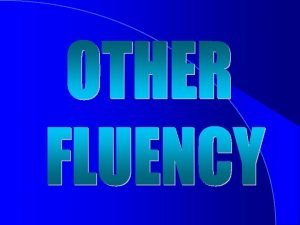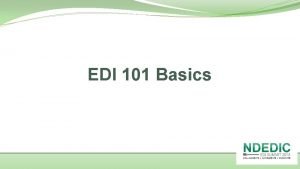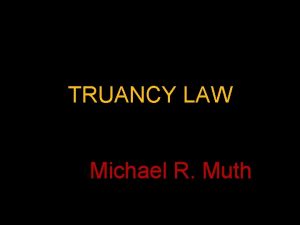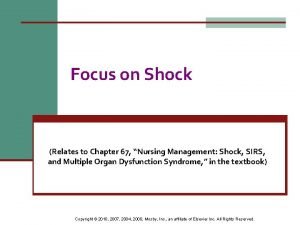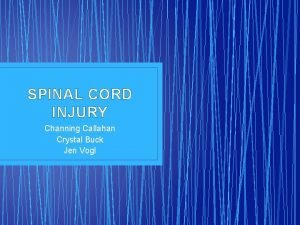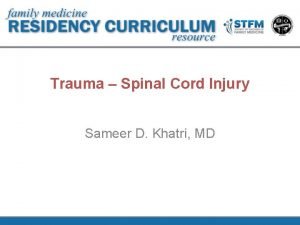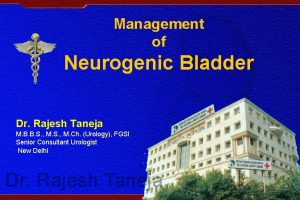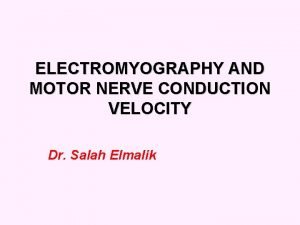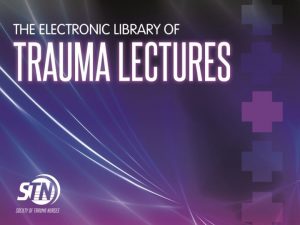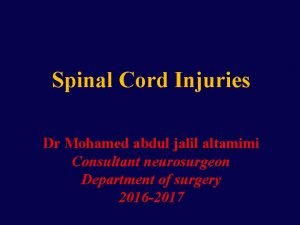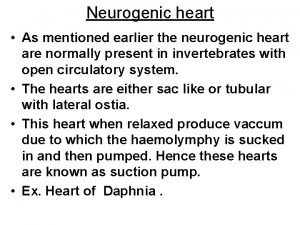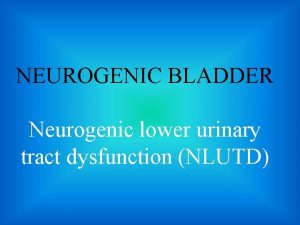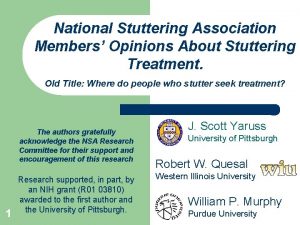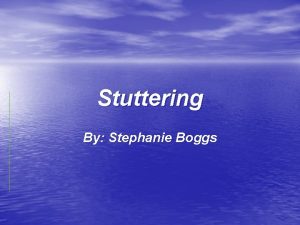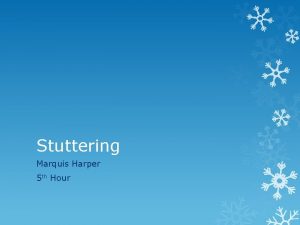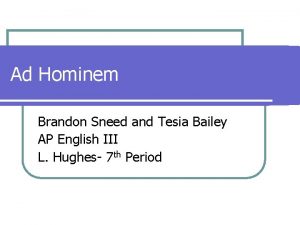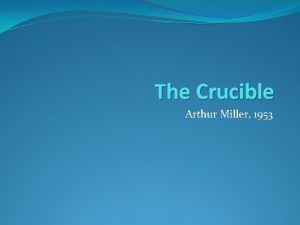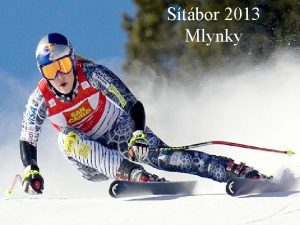Neurogenic Stuttering Lindsey Miller Tesia Muth What is










- Slides: 10

Neurogenic Stuttering Lindsey Miller & Tesia Muth

What is neurogenic stuttering? May occur due to a stroke, brain injury, tumor, dementia, or drug use. Six assessment criteria linked to neurogenic stuttering (1) Stuttering occurs on content and function words (2) The individual may be annoyed by the stuttering but not anxious (3) Stuttering may appear on initial, medial, or final position of words (4) Secondary behaviors rarely occur (5) No adaptation effect (some exceptions) 2010) complexity (6) The individual will stutter despite the type of speech task, time pressure, (Manning, or grammatical It is common for stroke patients to recover and not need therapy.

Stuttering Following Acquired Brain Damage: A Review of the Literature Distinguishing neurogenic stuttering from other disorders (i. e. , motor speech disorders, psychogenic stuttering) can be difficult because neurogenic stuttering is not confined to damage to one specific area of the brain. Characteristics of neurogenic stuttering: Disfluencies occur equally on grammatical and substantial words, Disfluencies may occur in all positions of words, A consistency of stuttering occurs across speech tasks, Negative reactions are not typical, secondary behaviors are rare, No adaptation effect Characteristics of psychogenic stuttering: Rapid & favorable response to treatment, struggle behaviors/anxiety, situational specific episodes, bizarre /unusual grammatical constructions Neurogenic vs. psychogenic speech disorders cannot be differentiated on the sole basis of disfluency characteristics Characteristics + Patient Response to Therapy = Ability to achieve the most differential diagnosis (Lundgren, Helm-Estabrooks, Klein, 2009)

Disfluency: An Exploratory Study of the Effects of Subcortical Stroke is one of the most common causes of brain damage resulting in neurogenic stuttering Purpose: To recognize the rate of disfluencies in individuals who had suffered a subcortical stroke Method: Speech samples at 1, 6, and 12 months were taken to measure the disfluency rate of both neurotypical and brain damaged individuals (12 Participants) Common neurogenic disfluencies that were exhibited: Repetitions False starts Revisions Filled pauses Results: The total number of disfluencies reduced within the first year following a stroke There is optimism for improvement of neurogenic stuttering following subcortical stroke (Ellis & Rittman, 2009)

Neurogenic Stuttering with Right Hemisphere Stroke: A Case Presentation A case study was conducted to illustrate the process of differential diagnosis between neurogenic and psychogenic stuttering Case: Twenty-nine year old African American male with initial symptoms including left facial numbness (resolved within 15 minutes), left sided weakness, and stuttering speech History: Family history of ischemic stroke Family members confirmed acute onset of speech difficulty No prior history of stuttering or speech and language difficulty as a child Assessment: Normal speech and language evaluations other than disfluencies (repetitions and prolongations) Exhibited many stuttering characteristics consistent with neurogenic stuttering Psychogenic stuttering was not outruled until MRI revealed small subcortical stroke Diagnosis:

Effectiveness of Speech Therapy in Neurogenic Stuttering: A Case Study Specific characteristics of neurogenic stuttering were identified and treated to determine the efficacy of speech therapy Case: 40 year old male History: Acute onset of stuttering following closed head injury Assessment: Stuttering Severity Instrument Increased rate of speech, repetitions on content and function words, pauses, prolongations, few secondary behaviors, stuttering on non-initial syllables, and no adaptation effect All characteristics were salient features of neurogenic stuttering Treatment: Fourteen sessions of therapy including pacing, easy onsets, precision fluency, airflow therapy, soft contacts, and continual phonation Results: Reduced rate of speech, and improved fluency and speech intelligibility Speech therapy is an efficacious manner to treat neurogenic stuttering

A Clinician Survey of Speech and Non-Speech Characteristics of Neurogenic Stuttering This study was designed to increase the knowledge of neurogenic stuttering by surveying speechlanguage pathologists working with individuals with neurological disorders. Method: Fifty-eight questionnaires were completed by SLPs who have worked with a patient with neurogenic stuttering in the past five years. The patients were grouped into different etiological categories: stroke, traumatic brain injury, neurodegenerative disease (Parkinson’s or Alzheimer’s), and other (brain surgery, encephalitis, epilepsy, use of medication, or unspecified cause). Results: The authors found stroke patients to be the most likely to be diagnosed with neurogenic stuttering. Neurogenic stuttering can be associated with lesions in almost every region of the brain. The most common types of disfluencies among the etiology groups were sound and syllable repetitions. (Theys, Wieringen & De Nil, 2008) Conclusion: There are possible differences and similarities with the characteristics of neurogenic stuttering between the different

Video Gentleman with Parkinson’s disease and neurogenic stuttering Pacing, rate control strategy https: //www. youtube. com/watch? v=ZXJ-khiv. Lr. U

Conclusion 1. It is important to know the characteristics of neurogenic stuttering to help achieve a differential diagnosis. 1. Stroke is one of the most common causes of neurogenic stuttering, however, there is optimism for natural recovery and for improvement with treatment. 1. There is efficacy in treating neurogenic stuttering with speech therapy.

References Burch, J. M. , Kiernan, T. E. , & Demaerschalk, B. M. (2013). Neurogenic stuttering with right hemisphere stroke: A case presentation. Journal of Neurolinguistics , 26(1), 207 -213. Ellis, C. , & Rittman, M. (2009). Disfluency: An exploratory study of the effects of subcortical stroke. Contemporary Issues in Communication Sciences and Disorders , 36, 149 -155. Kuriakose, T. , & Thammaiah, I. (2013). Effectiveness of Speech Therapy in Neurogenic Stuttering: A Case Study. Language in India, 13(12). Lundgren, K. , Helm-Estabrooks, N. , & Klein, R. (2010). Stuttering following acquired brain damage: A review of the literature. Journal of neurolinguistics , 23(5), 447 -454. Manning, W. H. (2010). Clinical Decision Making in Fluency Disorders (3 rd ed). Clifton Park, NY: Delmar. Theys, C. , Wieringen, A. V. , & De Nil, L. F. (2008). A clinician survey of speech and non-speech characteristics of neurogenic stuttering. Journal of Fluency Disorders , 33, 1 -23.
